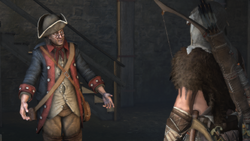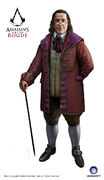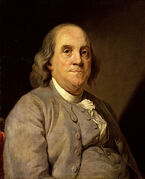就像我之前说的,我认为我们需要一个国家联盟,这是由议会法案赋予的,但却给我们的殖民地带来了更大的独立性。法国是一个迫在眉睫的威胁,我们没有准备好面对这些威胁。坦率地说,殖民地必须加入,否则就会灭亡。 ——本杰明·富兰克林在1754奥尔巴尼国会的表达
- “As I have stated previously, I believe we need a national union, granted by an act of Parliament but bringing greater independence to our colonies. The French are an immediate threat and we are ill-prepared to face them. To put it bluntly, the colonies must join, or die.”
- ―Benjamin Franklin at the Albany Congress, 1754.[来源]
本杰明·富兰克林(Benjamin Franklin,1706 – 1790)是美国国父中的一员,著名的博学者、印刷商、出版商、政治理论家、政客、邮政官员、科学家、音乐家、讽刺作家、社会活动家、政治家和外交家。
当海瑟姆·肯维抵达北美大陆的时候,富兰克林结识了他;在现实世界中,富兰克林与海瑟姆的儿子拉通哈给顿仅仅有一面之缘,然而在伊甸苹果所创造的出的幻境中,富兰克林成为其推翻华盛顿国王的行动中的一个有力盟友。
生平
早年生活
本杰明富兰克林1706年出生于波士顿,是肥皂制造商的第十个儿子。1718年,他开始为他的兄弟做学徒,尽管两人的关系很不稳定,尤其是在富兰克林的哥哥发现他以笔名——“杜古德夫人“写作后。之后,由于受欢迎的程度,他积累了大量的追随者。
Benjamin Franklin was born in Boston in 1706, the tenth son of a soap-maker. He began working as an apprentice printer for his brother in 1718, though their relationship was rocky, particularly after Franklin's brother found out that he had been writing for the paper under a pseudonym – Mrs. Silence Dogood – and amassed a large following due to its popularity.[1]
富兰克林于1723年离家出走,前往费城,这是他余生的主要居所。他继续在印刷和写作方面的事业,最终成为了宾夕法尼亚公报的出版商。他的年刊,《可怜的理查德》,成为了畅销书。
Franklin ran away in 1723 and headed for Philadelphia, which became his primary residence for the rest of his life. He continued his career in printing and writing, eventually becoming the publisher of the Pennsylvania Gazette. His yearly almanac, Poor Richard's Almanack, became a bestselling success.[1]
法国印第安战争
French and Indian War
- “I've begun to wonder if Parliament best serves our interests. The Colonies might be better off independent and autonomous. Most of my peers however, haven't taken kindly to the suggestion.”
- ―Benjamin Franklin speaking with Haytham Kenway.[来源]
我开始怀疑议会是否最能满足我们的利益。殖民地的独立和自治可能会更好。然而,我的大多数同龄人都没有对这个建议表示善意。——富兰克林向海尔森表达自己的立场。
In 1754, Franklin attended the Albany Congress to discuss ending tensions with the Iroquois and defending the colonies against the French. He proposed a unified government to better organize the colonies, and drew a cartoon, "Join, or Die", depicting the colonies as a snake cut into eight parts.
The proposal was accepted by the delegates at the conference, but the legislatures of the colonies and the British Board of Trade rejected the idea.[2]

富兰克林与海瑟姆·肯维和查尔斯·李对话
Afterwards, Franklin was staying in Boston when copies of his first almanac were stolen. Haytham Kenway noticed his distress, and offered a lending hand. Franklin expressed surprise, as those living in the colonial city usually refused to be of any help, and correctly assumed that he was new to Boston.
Franklin then requested that Haytham assist him with the task of finding stolen pages of his Almanac. Later on, Haytham met Franklin at the local general store, where he was writing a treatise on the benefits of having an older woman as a lover, much to Haytham's amusement.[2]
They met again another time, where Franklin explained the isolation he felt after the Albany Conference, as friends sought to distance themselves from his cartoon. He thanked Haytham for speaking with him, and began expressing his belief that the Thirteen Colonies should be independent from the British Crown, which greatly intrigued Haytham.[2]
In 1757, Franklin went to London to represent Pennsylvania in an ongoing legal battle with William Penn's family. It was the first of several extended political trips to Britain, and he would act as the state representative for Massachusetts, Georgia and New Jersey as well.[1]
American Revolution
- “We must indeed all hang together, or most assuredly we shall all hang separately.”
- ―Benjamin Franklin before signing the Declaration of Independence.[来源]

Franklin at the signing of the Declaration of Independence
Franklin was a vocal opponent of British impositions on the colonies (like the Stamp Act), and though he fought for the rights of colonists as British citizens, he became convinced that independence was the only real solution.
Unfortunately, Franklin's change of heart made him clash with his son, William, the Royal Governor of New Jersey. William remained an active Loyalist – the father and son never spoke again.[1]
Franklin contributed to the writing of the Declaration of Independence, which was primarily drafted by Thomas Jefferson. On 4 July 1776, Franklin was present alongside Samuel Adams, John Hancock, and Adams' ally Ratonhnhaké:ton, where he signed the Declaration right after Hancock.[2] For the rest of the American Revolutionary War, Franklin lived in Paris as America's ambassador to France.[1]
Two years before his death, Franklin voiced his support for the abolition of slavery, inspiring Washington to free his slaves in his will.[3]
Alternate timeline
After King Washington used the Apple of Eden to gain control over the United States, he put Franklin in charge of running Boston, and stamping out the rebels led by Samuel Adams. He also had Franklin build a special lock for the throne room for his palace in New York City.
Under the Apple's control, Franklin oversaw the execution of John Adams, and the burning of the Old North Church.[4]

Franklin with King Washington and General Putnam
When Ratonhnhaké:ton assassinated Benedict Arnold, the general told him he had to find Franklin and free him of the king's control. After Israel Putnam captured the Assassin, he brought him to Boston as a gift so the king would replace Franklin with him.
Franklin came to have a look, and tried to regain favor by revealing he had captured another Kanien'kehá:ka rebel, Kanen'tó:kon. The king ordered the two rebels to be executed alongside a score of random civilians as an example, which Franklin deemed to be rather harsh: the king reminded Franklin of his place, and then informed Putnam that he found Franklin to be going soft.[4]
However, the Kanien'kehá:ka duo escaped from their cells, and Franklin ordered his guards to find and kill them, fearing Washington would execute him if they escaped. Kanen'tó:kon fended off the guards while Ratonhnhaké:ton pursued Franklin. The governor used a merchandise lift to escape onto the rooftops, but Ratonhnhaké:ton transformed into an eagle and tackled him.[4]

Ratonhnhaké:ton and Adams discussing captive Franklin's fate
Injured, Franklin roused from Washington's control, but the king teleported in and fought off the Assassin, thereby maintaining his grip on Franklin. Ratonhnhaké:ton did not give up, intercepting a message from Franklin to Putnam to meet at the docks.
At the docks, Ratonhnhaké:ton watched Franklin meet with Putnam's messenger, who informed him the king had placed Putnam in charge of Boston.
The Assassin began firing arrows to capture Franklin, hitting him in non-fatal areas like the shoulder, injuries which again broke Washington's power over his mind. Franklin told Ratonhnhaké:ton he regretted what he did under the king's control, so the Assassin took him to Samuel Adams's hideout.[4]
Samuel Adams did not believe Franklin, but Ratonhnhaké:ton convinced him to spare Franklin based on the information he could give the resistance. Franklin revealed he had created a means of protecting Washington's palace, and asked Ratonhnhaké:ton to collect a unique metal from the blacksmith David Walston.
Ratonhnhaké:ton returned with a horse, revealing David had used his supply for horseshoes, which Franklin had to pry off with a crowbar. He then sent Ratonhnhaké:ton to recover his plans for the key from a soldier. However, when Ratonhnhaké:ton returned with the diagram, he also brought the grave news that Adams and his rebels had been slaughtered by Putnam at Boston Neck.[4]

Franklin disguised as a Bluecoat
Ratonhnhaké:ton stated they would have to leave Boston by sea, and Franklin suggested using the Aquila, a ship he had confiscated from Robert Faulkner.
Ratonhnhaké:ton stole a Bluecoat uniform for Franklin to pass through the streets unnoticed to meet Faulkner, whom they promised they would return his ship if they found a crew. The following morning, the rebels escaped on the Aquila, after Ratonhnhaké:ton assassinated Putnam.[4]
When they arrived in New York, the Aquila engaged and destroyed much of Washington's fleet, causing her to run out of gunpowder: Ratonhnhaké:ton ordered everyone on board to swim to shore while he rammed the ship. When Franklin came ashore, he was confronted by Washington, who tried to kill him for his betrayal.
Kanen'tó:kon attacked the king, ultimately dying so Franklin could escape. When Ratonhnhaké:ton arrived, Franklin informed him of what happened. Angered, the Assassin drank the tea of the Red Willow tree to undergo a spirit journey, and asked Franklin to watch over his body.
When he awoke, having gained the power of the bear, Franklin noticed the Assassin's eyes had turned an unusual blue.[5]

Franklin, Jefferson and Ratonhnhaké:ton during the attack on the Pyramid
The two rendezvoused with Thomas Jefferson's rebels. While Ratonhnhaké:ton stirred unrest in the city, Franklin suggested watching a rally Washington was giving to get a sense of how large his forces were.
Ratonhnhaké:ton's work paid off, turning the citizens on the king's men, scattering his forces across the city, allowing Jefferson's soldiers to attack the palace.
Jefferson and Franklin met with Ratonhnhaké:ton before he entered the palace gates, where Franklin gave him the key to open the throne room.[5]
Legacy
Franklin was an inventor and scientist. To this day, he is best known for flying a kite with a metal key attached to the bottom through storm clouds, to see if he could pick up an electrical charge and thereby prove lightning was electricity.[1]
He invented the Franklin stove, a metal fireplace that could be placed in the middle of a room, rather than outside. Its efficiency displayed itself in that it could use a quarter of the wood of a traditional fireplace, but gave off twice as much heat. This stove also had a much smaller chance of giving off a spark that would start a fire.[1]
Despite its ingenuity, Franklin decided not to patent the stove, as he wanted people to use his invention free of charge. This did not stop others from profiting with modified versions of the device, however.[1]
Accompanying this, he introduced the busybody, a set of three mirrors hung from a second floor window, based on a similar design he saw in Europe. These mirrors were angled so that people could look out to see who was knocking at their front door – a difficult prospect in parts of Philadelphia, where the buildings were high and narrow.[1]
From there, he created the glass armonica, a musical instrument consisting of bowls stacked together, which a person could use a treadle to turn and 'play' by running a wet finger along the turning edges of the bowls.
He came up with this idea after seeing someone 'play' water-filled wine glasses at a show in London. The armonica debuted in London in 1762, and became quite popular for a time – particularly in Germany, where Mozart wrote two pieces for it.
However, its success was short-lived, because there was no way to amplify it to be heard in large concert halls at the time.[1]
Ratonhnhaké:ton crafted these inventions, and the kite and key, in a room at the Davenport Homestead after locating the stolen almanac pages. In a separate room, he kept copies of Poor Richard's Almanack.[2]
琐闻趣事
- Franklin's advice to pursue relationships with older women came from the letter "Advice to a Friend on Choosing a Mistress".
- Franklin's cartoon "Join, or Die" was displayed prominently around Boston.
- Although the kite and key could be crafted by Ratonhnhaké:ton, it is unknown if Franklin actually performed the experiment.
- In the The Tyranny of King Washington, Franklin wears the same outfit as François-Joseph Paul de Grasse.
画廊
参考与注释
- ↑ 1.0 1.1 1.2 1.3 1.4 1.5 1.6 1.7 1.8 1.9 Assassin's Creed III - Database
- ↑ 2.0 2.1 2.2 2.3 2.4 Assassin's Creed III
- ↑ George Washington's notebook
- ↑ 4.0 4.1 4.2 4.3 4.4 4.5 Assassin's Creed III - The Tyranny of King Washington: The Betrayal
- ↑ 5.0 5.1 Assassin's Creed III - The Tyranny of King Washington: The Redemption
| ||||||||||||||||||||||||||||||||||||||||
| ||||||||||||||||||||
| ||||||||||||||||||||||||||||||||||
| 如果您认为本词条还需改进,欢迎参与编辑。任何疑问请阅读欢迎页面或这里留言。 |




